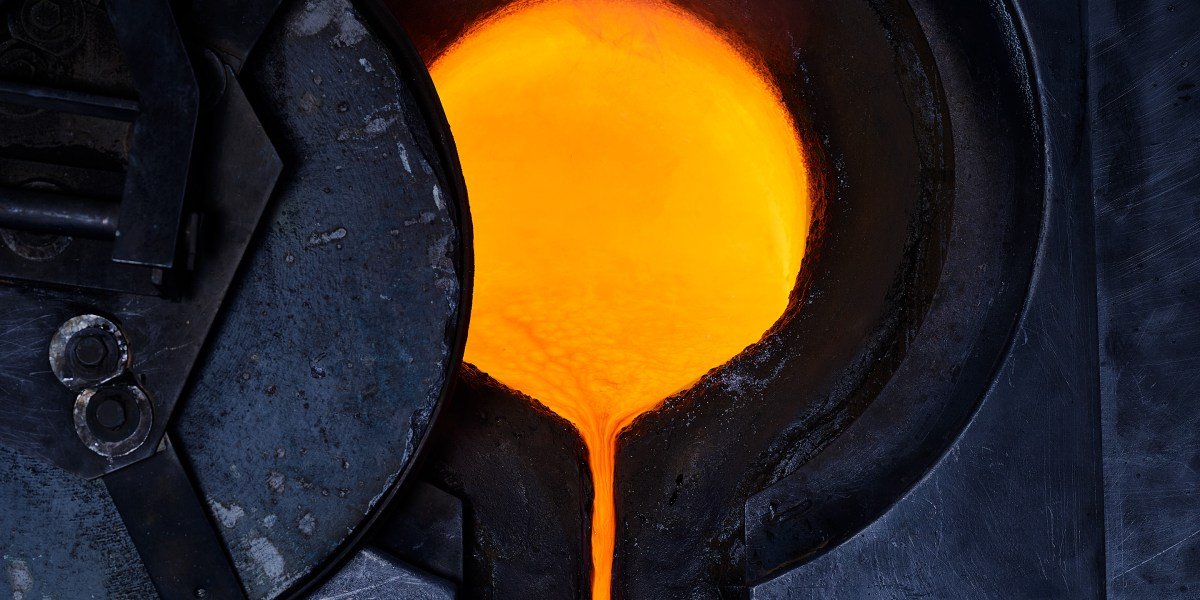Some 1,350 feet deep and two miles across at its widest point, the Cortez open-pit gold mine outside Elko, Nev., looks like an asteroid crater—the largest hole in the ground you’ve ever seen. Standing at its edge, you can watch a constant stream of 24-foot-tall hauler trucks make the roughly hour-long trip into the abyss to collect pay dirt.
You’d need a ladder to climb into the cab of one of these monsters, which weigh over a million pounds each, and stop their steady crawl only to switch drivers, fill their 1,200-gallon tanks with diesel, or load up 370-ton payloads of gold ore. From up here, perspective tends to warp: Townhouse-size trucks begin to look like ants as they descend, and their operators entirely slip from view.
Off in the distance, you can make out a few of the 21 other mines in this complex in the desolate high desert. Nevada Gold Mines—a joint venture between the world’s largest gold mining companies, Barrick Gold and Newmont Corp.—is the most productive gold mining operation on earth.
The microscopic gold dust in those 370-ton truckloads of dirt can’t be seen with the naked eye, but after the entire pile has gone through the latest high-heat, pressure, and chemical processes, one load will on average yield about 10 ounces of gold—approximately the weight of a roll of quarters. That’s a lower yield than some other mines, but it’s consistent: When you have dozens of trucks servicing 22 mine sites 24 hours a day, seven days a week, the rolls of quarters add up—to the tune of nearly 85 tonnes of gold, worth $8 billion, last year. NGM edged out sites in Uzbekistan and Siberia for the title of world’s most productive gold mining site in 2023.
Successful gold mining today bears little resemblance to the storied era of America’s first gold boom: rough-and-tumble 19th-century boomtowns cropping up overnight to accommodate speculative prospectors, chasing gold veins and rumors.
It’s also nothing like the gold industry that has prevailed since the 1980s, when dozens of mostly small companies competed to mine gold deposits as quickly as they could, often overextending themselves and failing once the market receded.
What’s going on right now is methodical, measured, even cautious in comparison. The key players in the mining industry aren’t enterprising individuals or small firms anymore: They’re multinational corporations guided more by share prices and boardroom politics than the dream of striking it rich.

Spencer Lowell for Fortune
The traditionally volatile gold industry has been reshaped by these massive corporations—as has the town of Elko, once known as much for its unconcealed vices as its rich mineral veins. This rough-hewn mining town is now a bedroom community for highly paid miners and engineers, who mostly live in its well-to-do suburbs with their families.
“What we’re seeing today is consolidation across the sector,” mining engineering professor and former Newmont SVP M. Stephen Enders tells Fortune.
Indeed, in 1993, gold was produced at around 200 lode mines in the United States. Last year, active mines numbered less than a quarter of that, according to the United States Geological Survey. “It’s all for the same reason,” Enders explains. “It’s for efficiencies, it’s for scale, it’s to maintain your corporate life by having reserves…in the ground.”

In short: The stereotypically boom-and-bust gold industry has grown up. Scale and cautious growth have become key parts of the corporate mining playbook—resembling the strategies of oil and natural gas producers who calibrate production to market, political, and other priorities.
“We’ve transitioned out of the midcap, lower-cap, instant gratification model,” said Barrick CEO Mark Bristow in an August earnings call. “We’re in there for the long term.”
And these modern, corporate miners are in the right place at exactly the right time: A bull market driven by central banks and “average Joe” consumers has sent gold prices soaring to all-time highs and put the precious metal back in the spotlight. Gold prices have surged 60% in the past two years alone, from under $1,650 per ounce to a recent high point of over $2,700.
With traditional sources of gold demand—mainly Western institutional investors—now slowly coming back to the market, and supply from a new-look mining sector remaining subdued even in the face of a steady stream of demand, gold could have a bright future ahead of it.
Gold has been used as a currency for over 2,500 years, and for everyone from the Spanish conquistadors to Scrooge McDuck, it has represented wealth and abundance. The argument for why this particular metal is precious has been roughly the same since the Byzantine Empire: It’s rare, hard to find, and can be difficult to extract. All the gold ever discovered on earth would fit into roughly five Olympic-size swimming pools.
Plus: It’s shiny. And people just seem to like it.
That shiny stuff—like dollar bills, numbers on a blockchain ledger, and most other forms of currency—is, in a strictly practical sense, pretty much useless. Yes, the soft, malleable metal does have some utility in niche areas such as dentistry, aerospace, and high-end electronics. But gold’s value rests largely upon its scarcity and its mystique: It’s precious because we have decided it is.
For decades, investors who bet heavily on gold—goldbugs, as they’re known colloquially—have preached a consistent narrative: The value of your dollars or drachmas or Dogecoin could collapse at any moment, but gold is a safe-haven asset, perfect for times of economic stress or political unrest. It’s a hedge against inflation as well as surging government deficits that risk currency devaluation. It will always be worth something—or at least that’s the story.

Spencer Lowell for Fortune
The period surrounding the Global Financial Crisis seemed to prove the goldbugs right. Between 2008 and 2012, as markets worldwide faltered, the value of the precious metal more than doubled, far outpacing the S&P 500, which declined in value.
In the decade following, however, goldbugs’ arguments began to sound pretty stale. As the U.S. economy roared back after the financial crisis, the gold bull market collapsed, with prices falling some 40% between 2012 and 2015.
Even after this bust, some investors kept on beating the drum, warning of the impending collapse of the dollar, and maybe the world order with it. Billionaire investor Stanley Druckenmiller said on CNBC in early 2016 that gold “remains our largest currency allocation.” He warned viewers: “Get out of the stock market.”

Spencer Lowell for Fortune
If you’d followed Druckenmiller’s advice and bought and held a gold ETF—perhaps the popular SPDR Gold Shares (GLD), which tracks spot prices for physical gold—you’d have seen returns of over 110% through the present day. That’s not bad, but it hasn’t won many points for the goldbugs, given that the S&P 500 has soared more than 200% over the same period.
Gold’s underperformance compared with stocks has made it easy to dismiss proponents of gold: Some analysts ridicule them for hoarding a useless, non-interest-bearing asset in preparation for an apocalypse that may never come.
Now the goldbugs are back in the spotlight—and not as the butt of a joke anymore. Between the pandemic, inflation, rising government debts, wars in Ukraine and the Middle East, China’s economic woes, and a white-knuckle U.S. election, many of their warnings have come to feel like realities.
Interest rates are now on the way down as well—another bullish signal for gold. Because precious metals are a non-interest-bearing asset, gold becomes more attractive to investors in a lower-rate environment, as yields decline on assets such as Treasuries.
Historically, western institutional investors have been the gold market’s engine, driving prices up as they diversify away from riskier assets, particularly in volatile times like the 1970s and after the 2008 financial crisis.
But this time around, there are two unexpected classes of investors who are the real heavyweights behind gold’s price run: global central banks and Chinese consumers, who are upending analysts’ assumptions.
Central banks are feeling skittish these days after years of inflation and geopolitical tensions, and they’re looking to gold as a safety net. Also, the U.S. and its allies freezing (and potentially seizing) billions in assets from Russia after its invasion of Ukraine has shown that if you make Uncle Sam angry, holding U.S.-based assets on your balance sheet can be risky. China in particular has been “de-dollarizing” and selling off U.S. Treasury holdings for over a decade.
Turkey kicked off the central bank buying spree in 2022 by purchasing 148 tonnes of gold. Then, in 2023, China’s central bank bought 225 tonnes of gold. The central banks of Poland, India, Uzbekistan, the Czech Republic, and more have followed suit. All told, global central banks purchased an eye-watering 2,500 tonnes of gold from 2022 through the middle of this year. That’s just over $220 billion worth at today’s prices—more than double the total in 2021. These banks are on pace for another record year of gold purchases in 2024.
China is indisputably leading the charge. The severe deterioration of the real estate market and a slump in Chinese stocks have given gold a new luster, and the enormous appetite for gold that China’s central bank has shown has rippled out to Chinese citizens too.

Spencer Lowell for Fortune
In 2023, Chinese consumers bought 287 tonnes of gold bars and coins, according to the World Gold Council, 27% more than the prior year. Tellingly, growth in bar and coin sales outpaced the jewelry sector by more than double—signaling that consumers are flocking to gold as an investment more than as a splurge or status symbol.
In the U.S., average Joes are getting into the market, too: The bigbox chain Costco made waves when it began selling one-ounce gold bars at select stores, and it’s now selling up to $200 million in gold per month, according to a Wells Fargo estimate. It can’t keep the bars on the shelf.
“Stocks can fall. Crypto can go to nothing. We’ve seen that real estate can take a dive,” Emery Bowles, an IT specialist who works for the federal government and has made some personal investments in gold, tells Fortune. “I like having something that has lasting value and always will.”
Some are predicting that Western institutional investors will be the next class of gold buyers to start piling in, driving prices up even further.
Gold ETF inflows from Western nations, the traditional driver of gold prices, have been sluggish in recent years. Paradoxically, that could be a bullish signal for gold looking forward, says Imaru Casanova, a portfolio manager of precious metals at the investment management firm VanEck: One of the reasons she’s bullish on gold prices is that they’ve managed to rise without Western institutional investment.
“When those inflows are coming in, we could see gold up another $300, $400 from here,” Casanova says.
And there is some evidence that Western investors are coming back to gold: Global physically backed gold ETFs have now seen inflows every month going back to March, with North America ETFs contributing the most to the trend.
As in any market, demand is just one side of the coin. There’s no better example of how gold’s supply side—the mining sector—is adapting than the town of Elko. In the early 1850s, thousands of prospectors fanned out across the Western U.S. in search of gold. Twenty years later, most of the easily accessible gold was gone, and most miners were broke, but in the tiny town of Elko—nestled in the rugged high desert of the Ruby Mountains—the gold rush chugged along.
Over the decades, waves of small, enterprising companies continued to mine Elko’s rich gold deposits. Over time, they began to merge and consolidate, to the point where today, there’s really only one player left in what has essentially become a company town: Barrick Gold and Newmont Corp.’s Nevada Gold Mines.

Spencer Lowell for Fortune
The brothels and casinos that once dominated the town have mostly disappeared, giving way to tidy housing developments, day-care centers catering to mining families, and dozens of booked-out discount hotels for the mining consultants NGM flies in from around the world.
“We still have kind of a hardscrabble population here, but we also balance that out with a lot of mine professionals,” Elko Mayor Reece Keener says. “There’s a lot of wealth here in the area. And again, you might see someone sitting on a barstool that drove up in a beatup old truck, who, you know, has a significant net worth.”
Toronto-based Barrick and Denver-headquartered Newmont, with market caps of $32.2 billion and $50.6 billion, respectively, were regional rivals for decades, launching hostile takeover bids and competing to buy mining rights from the smaller companies that crowded the area around Elko. Their operations and mine sites eventually became so interwoven that a joint venture became the obvious solution. So, in 2019, Newmont and Barrick decided to pool their capital and build the most advanced gold operation in the world.
Mining complexes like NGM are bigger, more efficient, and more consistently profitable than ever before. But even as gold prices have soared, they have kept their output relatively consistent. In 2018, global gold mining production hit a record of 3,657 tonnes, according to the World Gold Council, while in 2023 it was 3,644 tonnes.
Some would argue that NGM and its ilk are leaving money on the table: They have the capital and the capacity to take advantage of the strong market by ramping up production. But NGM executives say they’re focused on the long-term sustainability of their venture, rather than reacting to the whims of the market.
The point is to not kill the goose that lays the golden eggs, explains NGM managing director Henri Gonin: Digging up all the high-grade gold ore to make as much money as possible right away could “kill the business in the long run,” he says. “There’s a delicate balance there between extending the value and maximizing the value.”
That emphasis on stability and measured growth is apparent the minute you set foot on NGM’s sprawling campus, two hours outside Elko. Instead of searching for riskier, yet-to-be-discovered “greenfield” gold deposits, NGM has directed its capital toward building so-called brownfield mines—in ground that has already been mined for years.
Most of what’s left in these brownfields are what geologists call “Carlintype deposits”—earth that contains gold mixed into dirt or rock at the molecular level, invisible but extractable through chemical processing. NGM’s billion-dollar machines use high heat and extreme pressure to separate the gold from the ore. That process isn’t 100% effective, though, so the used ore still containing trace amounts of gold—referred to as “tailings”—is deposited in giant piles scattered around NGM’s complex. Those piles are sprayed down with a liquid cyanide solution in a process known as “cyanide heap leaching,” which chemically separates gold molecules from the tailings.

Spencer Lowell for Fortune
Environmentalists in the U.S. and abroad have criticized the waste generated by heap-leach processing, and the devastating environmental consequences of mishaps. In June, a spill at a mine owned by the Canadian company Victoria Gold contaminated a Yukon watershed with 2 million tonnes of material contaminated with cyanide, forcing the closure of the mine and leaving taxpayers with $111 million in restoration costs. Still, the practice remains legal, with a permit, in Nevada.
On the drive to the mine complex from downtown Elko, speeding along Interstate 80 with the Ruby Mountains to our left, Gonin had to point out the signs of Elko’s biggest industry in the barren high desert landscape. That small mountain off the side of the road? It’s actually a man-made pile of mining debris, waiting to be reprocessed for its residual gold content. The warehouse far in the distance? NGM’s roaster, the $1 billion machine that heats ore to over 1,000 degrees to extract the invisible specks of gold from it.
At Goldrush, one of NGM’s underground mines—subterranean mazes where engineers use drills and carefully placed explosives to burrow into solid rock and extract gold ore without disturbing the mountains above them—all that’s visible from the surface is an unassuming 18-footwide tunnel carved into a rock face. Once you drive deep enough into the access tunnel that you’re out of reach of the sunlight, the mine opens up into a serpentine maze of subterranean shafts and tunnels as deep as 2,000 feet below the surface.
Mining has gotten much safer in the U.S. over the past few decades, although accidents still happen. The underlying risks are clear from the gear required to enter Goldrush: boots, hard hats, tool belts, vests, and emergency carbon dioxide scrubbers.
Driving around the NGM site, the whole operation felt rather buttoned-up and corporate. This is a professional construction crew working a sophisticated multibillion-dollar operation, not a group of prospectors looking to strike it rich quick. NGM employees—who make six-figure salaries and mostly live in suburban subdivisions—will routinely spend 12 hours a day underground, sometimes without taking breaks to see the sun.
Deep underground, the loudest noises are the crunching of gravel and splashing of water under rubber boots, which echo off the solid rock walls of the 18-foot-wide tunnels. No matter the time of day, a low hum of hydraulic drills and mining trucks can be heard: The miners are always digging.
For long-term gold investors, the mining companies’ shift to a steady, profit-focused mindset is clearly beneficial—and may even tamp down the cycle of boom-andbust that the sector is notorious for. Investors have been burned by past crashes, most notably in the early 1980s, when gold prices fell some 45% as the Federal Reserve hiked interest rates to stop runaway inflation; and in 2013, when gold prices plummeted around 35%, reversing the gains of the Global Financial Crisis–fueled run toward gold.
In 1997, when a spree of central bank selling sent gold prices down by double-digit percentage points, many junior mining companies were forced to cut costs, hurting their investors and communities. It was a terrible time in Elko, Keener says. “I was here in ’97, when the gold prices plunged,” he recalls. “There were mass layoffs at all of the mines … And it was debilitating, because there were tons of foreclosures. People literally were just, you know, moving out and leaving the keys on the counter.”
Analysts say that a more corporate, consolidated mining sector means companies, their employees, and their investors will be better protected from the whims of the market.
“The reason why you have the boom-bust cycles, particularly for the miners, is because when prices go up, there’s a flood of investment to create production capacity, and companies often pay too much for limited inputs,” says Bob Elliott, cofounder and CEO of investment firm Unlimited. Now, he adds, by effectively lessening the supply of new gold entering the market, gold miners are tilting the fundamentals toward continued steady price growth.
Of course, there are no guarantees when it comes to gold, and another bust could be around the corner. After all, the metal’s worth floats on air—even if that air has supported it for millennia.
This article appears in the December 2024/January 2025 issue of Fortune with the headline “The new gold rush.”














Leave a Reply